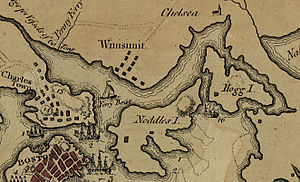Meeting “Capt. Yoking”
This is Avery’s entry from 29 May 1775 as the provincial forces finished salvaging useful material from H.M.S. Diana, which had run aground during the fighting.
29. Monday. Lodged last night in a comfortable bed. Went down to the Ferry, much treasure was got out to-day. Two large anchors & one Kedge & several large square pig iron as ballast, with several articles of consequence & a barrel of pork.When this diary was published in the D.A.R.’s American Monthly Magazine in 1900, the word I typed as “Kedge” (a sort of small anchor) was transcribed as “Kelly.” I haven’t seen the original document to confirm my guess.
Avery’s entry continued:
About noon Capt. Yoking, a Stockbridge Indian & I reconnoitered the Ground East of the schooner & judged that the taking off the cattle was practicable. The Capt. with 3 men took a canoe & went about a mile & a quarter upon the north side of the river from the Ferry & went across to Noddle’s Island & reconnoitered & scouted round about an hour & a quarter, when he fixed his centuries & another canoe went over to his assistance & soon took 2 horses & mired a 3d when a cannon ball fell pretty near them & four barges landed upon which all the scout retreated to the main shore & came over.The reference to “Capt. Yoking, a Stockbridge Indian” is very interesting.
Upon that I advised that they should go back & get the stock. Accordingly they got off the Stock about sunset.
Stood upon guard two hours near Winnisimmit Ferry. Prayed with company.
Massachusetts Soldiers and Sailors of the Revolutionary War notes one state record of a captain named Jehoiakim Youkin in Col. John Paterson’s regiment. The same name also shows up on the records of Gen. George Washington’s headquarters. In August 1775 the general’s military secretary, Joseph Reed, paid Jehoiakim Youkin for digging necessaries—though perhaps he was collecting money for other men.
According to Patrick Frazier’s The Mohicans of Stockbridge, Jehoiakim Yokun or Yokum was a Mahican leader and landowner in western Massachusetts in the mid-1700s. Sites in the region still bear the Yokun name.
When the war began, Jehoiakim’s son Timothy Yokun became the first sergeant in Capt. William Goodrich’s company of Stockbridge Indians within Col. Paterson’s regiment. These soldiers were part of the Massachusetts forces and yet set apart in their style of living and fighting. Most company records don’t list Jehoiakim Yokun’s name at all. But evidently he was in command alongside Goodrich, perhaps particularly in combat. Less than two months into the war, Avery was calling him “Captain.”
One historian appears to have conflated father and son, saying Timothy gained the rank of captain during the war. Yet other authors list Timothy Yokun among the Stockbridge soldiers killed by Lt. Col. John Graves Simcoe’s rangers near Yonkers, New York, in August 1778. Diaries of the Sullivan expedition, the postwar diaries of the Rev. Samson Occom, the pension application of David Freemoyer, and an early history of the town of Stockbridge all refer to a “Captain Yoke or Yokun” active later in the war and returning to Stockbridge afterwards. That was most likely Jehoiakim.
Another source tells us the name of one of the Stockbridge men who went out onto Noddle’s Island and brought back those two horses. As quoted here, he was Henries Vomhavi. The Provincial Congress granted him the smaller of those two horses as a reward.




